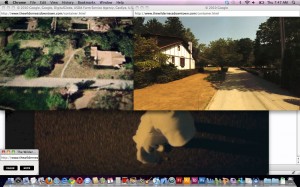You probably saw this last week, but its implications are far-reaching enough that it bears bringing up again.
Indie rock band The Arcade Fire released an interactive music video for their song “We Used To Wait,” from their album, “Suburbs.” At the beginning of the video, you’re asked to enter the address for the home where you were raised. Once you type that in, it processes for a few seconds and then tells you you’re ready to start.
And then your mind is blown.
The video begins with a guy running down the street, and other windows pop up showing the street and the sky. Those windows collapse as new ones appear, all as this guy keeps running down the street. As he progresses, the bird’s eye view of the town in which he’s running becomes clearer, and you start to see familiar settings…
He’s running to your childhood home, or what Google Street View has on file of your home. Or, in the screen grab above, my childhood home. And then you’re given the chance to write or draw a postcard to your childhood self.
You’re hooked now, and totally want to do this for every home you’ve ever lived, right? You should know: This video requires a browser that reads HTML5. It was designed in partnership with Google Chrome, which you can download for free, but can also run on Safari.
Journalists of all crafts, take note:
- This is truly interactive. Sometimes we’ll call things “interactive” when the interaction is rolling over or clicking. Those types of interactives have their place, but this is an interactive that requires a few levels of input from the user. First, the user needs to type in the address. Later in the video, the user moves the video along by writing or drawing a postcard to his or her younger self. Thus…
- You can do this over and over before getting bored. You will never have the same experience with this video. Even if you type the same address, you’re still going to be asked to write or draw a postcard to yourself. And even if you write the same text, the experience won’t be the same. (I won’t tell you much more, except that your text begins to move.)
- This shows some cool things HTML5 can do. Sure, you’re not going to make videos like this, per se, but if you’ve been trying to convince people in your department why you should be paying attention to HTML5, this will help your argument.
- This works because it’s so personal. People love to look for themselves and loved ones in things. It’s the reason why people spend time with county-by-county maps, whether they’re for election results or home prices. It’s why searchable databases get so much attention. This video’s use of technology and interactivity really work because of the connection to the user. I typed in the house where we lived when I was born, the house where I spent most of my childhood, my friends’ houses, etc. This will entertain me (and you) for hours.


